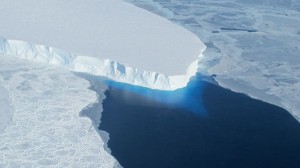Water Closet for May 23, 2014
“Death by a thousand cuts” has become a cliché. How about, “drowning coastal lands by a thousand melts” to describe the rising seas and diminishing glaciers? The latest reports* this month by climate scientists surprisingly use words like “inevitable”, “tipping point”, “unstoppable”, “collapsing”, and “wow” when reporting on West Antarctica’s huge glaciers moving toward oblivion. [pullquote]”Antarctica’s collection of vast glaciers may move into the sea raising the oceans as much as 10 feet”[/pullquote]We’ve long known of Greenland’s and relatively small mountain glaciers waning; their waters flowing to rising seas. Now some of the very largest glaciers are joining them.

Thwaites Ice Shelf
Calving front of the Thwaites ice shelf in West Antarctica is seen on October 16, 2012. Recent studies indicate the melting shelf is causing the glaciers behind it to collapse. – James Yungel, NASA Photo
This May the media have continued to gather water woes around the world from California’s long drought and subsequent fires to the seaward sliding glaciers of West Antarctica. The glaciers’ bottoms and ways are being greased by warming ocean water seeping in underneath. Estimates vary but many of those researching the subject think that in 200 years the whole of west Antarctica’s collection of vast glaciers may move into the sea raising the oceans as much as 10 feet. This does not include the rise from other melting glaciers around the world. Estimates from those range from 0.5 to 3 feet by 2100. While 200 years is a long time for politicians, it is hardly any time at all for climatologists and geologists.
One old Closeteer’s son with a high school freshman daughter got rid of his TV last year to avoid in part wars, fires, tornadoes, and floods. He wants himself and daughter to do things, not watch. Some might say he is burying his head in the ice to use a metaphor with a cold twist. What can anyone do about climate change especially after tipping points have passed and positive feedback systems have kicked in? The people in south Florida, the Maldives, Venice, and Bangladesh will have to move to higher ground or houseboats if the predictions for this and the next century come to past. While three and ten feet rises on average don’t seem much we must add storm surges. Chatham, Plum Island and Salisbury beaches will go under during northeasters. Upon retreat there may be nothing left behind but twice daily water covered sand bars. The salt marshes, buffer to uplands, will be gone. A mechanic climbing the Ipswich wind turbines for maintenance will look eastward at the sea dotted by a dozen islands, once hills connected by roads to the mainland. In the Water Closet for grim fun we got our Ipswich quadrangle USGS map out and marked the three meter (about 10-ft.) contour above mean low tide in red. Everything below it might be seawater by this century’s end.
We old timers will miss the sad migrations up from the coast. As with all such changes the poor, not having the money to easily move, will be affected the most. People, their machines and other power sources have been indicted by most scientists as being significantly to blame for global warming. Those deniers with heads in the ice may soon be exposed by melting. Having said this, we hope the former are wrong, the latter right. Until we find out, it might be prudent to listen to the large majority of people who study climate change.
Such changes are far too big a subject for us Stream Teamers to comment further on. We do recommend a very recent National Geographic Daily News on line article summarizing the scientific reports on the West Antarctica glaciers so widely reported last week.* Its graphics, maps, and photos are excellent; the accompanying text cautious.
While writing this, someone reminded us of the Wisconsin continental glacier covering the land here with two-miles of ice 15,000 years ago. As it melted, the ocean rose several hundred feet. Some of the West Antarctic glaciers are also about two miles thick. Another Closeteer complained upon reading articles about the reports that a line from a Simon and Garfunkel song won’t get out of his head. What is it?” we asked. “Slip sliding away.” He answered. “Neat.” We old timers responded, meaning the same as the more modern “cool”, but alas not cool enough. The warmer ocean water has gotten under the coastal glaciers that are now sliding toward the open sea.
* NASA study in Journal of Geophysical Research Letters, Eric Rignot, chief author; and report by glaciologist Ian Joughin, University of Washington Applied Physics Laboratory
______________________________________________________________________
WATER RESOURCE AND CONSERVATION INFORMATION
FOR MIDDLETON, BOXFORD AND TOPSFIELD
| Precipitation Data* for Month of: | Feb | March | April | May | |
| 30 Year Normal (1981 – 2010) Inches | 3.25 | 4.65 | 4.53 | 4.06 | |
| 2013 – 14 Central Watershed Actual | 4.34 | 4.32 | 2.86 | 1.7 as of 5/20** | |
Ipswich R. Flow Rate(S. Middleton USGS Gage) in Cubic Feet/ Second (CFS):
For May 20, 2014: Normal . . . 64 CFS Current Rate . . . 52 CFS
*Danvers Water Filtration Plant, Lake Street, Middleton is the source for actual precipitation data thru April. Normalsdata is from the National Climatic Data Center.
**Updated May precipitation data is from MST gage..
THE WATER CLOSET is provided by the Middleton Stream Team: www.middletonstreamteam.org or <MSTMiddletonMA@gmail.com> or (978) 777-4584

